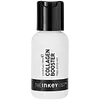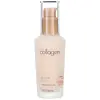What's inside
What's inside
 Key Ingredients
Key Ingredients

 Benefits
Benefits

 Concerns
Concerns

No concerns
 Ingredients Side-by-side
Ingredients Side-by-side

Water
Skin ConditioningGlycerin
HumectantButylene Glycol
HumectantPropanediol
SolventPhenoxyethanol
PreservativeHydroxyethylcellulose
Emulsion StabilisingDisodium EDTA
Leuconostoc/Radish Root Ferment Filtrate
AntimicrobialCarbomer
Emulsion StabilisingHyaluronic Acid
HumectantPalmitoyl Dipeptide-5 Diaminobutyroyl Hydroxythreonine
Skin ConditioningPalmitoyl Dipeptide-5 Diaminohydroxybutyrate
Skin ConditioningPolysorbate 20
EmulsifyingPalmitoyl Tetrapeptide-7
Skin ConditioningPalmitoyl Tripeptide-1
Skin ConditioningWater, Glycerin, Butylene Glycol, Propanediol, Phenoxyethanol, Hydroxyethylcellulose, Disodium EDTA, Leuconostoc/Radish Root Ferment Filtrate, Carbomer, Hyaluronic Acid, Palmitoyl Dipeptide-5 Diaminobutyroyl Hydroxythreonine, Palmitoyl Dipeptide-5 Diaminohydroxybutyrate, Polysorbate 20, Palmitoyl Tetrapeptide-7, Palmitoyl Tripeptide-1
Water
Skin ConditioningHydrolyzed Collagen
EmollientGlycereth-26
HumectantButylene Glycol
HumectantCyclomethicone
EmollientButylene Glycol Dicaprylate/Dicaprate
EmollientMangifera Indica Seed Butter
Skin ConditioningPEG-32
HumectantGlyceryl Polyacrylate
Ethoxydiglycol
HumectantPEG-20 Methyl Glucose Sesquistearate
EmulsifyingLaminaria Japonica Extract
Skin ProtectingCetyl Alcohol
EmollientPolysorbate 60
EmulsifyingPolyacrylate-13
Sorbitan Oleate
EmulsifyingCaprylyl Glycol
EmollientPolyisobutene
Parfum
MaskingMethyl Glucose Sesquistearate
EmollientGlycerin
HumectantEthylhexylglycerin
Skin ConditioningDimethicone
EmollientHydrolyzed Malt Extract
Skin ConditioningSaussurea Involucrata Extract
HumectantTocopheryl Acetate
AntioxidantPanthenol
Skin ConditioningStearic Acid
CleansingPolysorbate 20
EmulsifyingArctostaphylos Uva Ursi Leaf Extract
Skin ConditioningCarbomer
Emulsion StabilisingTriethanolamine
BufferingXanthan Gum
EmulsifyingBHT
AntioxidantDisodium EDTA
CI 15985
Cosmetic ColorantCI 14700
Cosmetic ColorantWater, Hydrolyzed Collagen, Glycereth-26, Butylene Glycol, Cyclomethicone, Butylene Glycol Dicaprylate/Dicaprate, Mangifera Indica Seed Butter, PEG-32, Glyceryl Polyacrylate, Ethoxydiglycol, PEG-20 Methyl Glucose Sesquistearate, Laminaria Japonica Extract, Cetyl Alcohol, Polysorbate 60, Polyacrylate-13, Sorbitan Oleate, Caprylyl Glycol, Polyisobutene, Parfum, Methyl Glucose Sesquistearate, Glycerin, Ethylhexylglycerin, Dimethicone, Hydrolyzed Malt Extract, Saussurea Involucrata Extract, Tocopheryl Acetate, Panthenol, Stearic Acid, Polysorbate 20, Arctostaphylos Uva Ursi Leaf Extract, Carbomer, Triethanolamine, Xanthan Gum, BHT, Disodium EDTA, CI 15985, CI 14700
 Reviews
Reviews

Ingredients Explained
These ingredients are found in both products.
Ingredients higher up in an ingredient list are typically present in a larger amount.
Butylene Glycol (or BG) is used within cosmetic products for a few different reasons:
Overall, Butylene Glycol is a safe and well-rounded ingredient that works well with other ingredients.
Though this ingredient works well with most skin types, some people with sensitive skin may experience a reaction such as allergic rashes, closed comedones, or itchiness.
Learn more about Butylene GlycolCarbomer is a polymer of acrylic acid. Its main role is to create a gel consistency.
A high amount of carbomer can cause pilling or balling up of products. Don't worry, most products contain 1% or less of carbomer.
Disodium EDTA plays a role in making products more stable by aiding other preservatives.
It is a chelating agent, meaning it neutralizes metal ions that may be found in a product.
Disodium EDTA is a salt of edetic acid and is found to be safe in cosmetic ingredients.
Learn more about Disodium EDTAGlycerin is already naturally found in your skin. It helps moisturize and protect your skin.
A study from 2016 found glycerin to be more effective as a humectant than AHAs and hyaluronic acid.
As a humectant, it helps the skin stay hydrated by pulling moisture to your skin. The low molecular weight of glycerin allows it to pull moisture into the deeper layers of your skin.
Hydrated skin improves your skin barrier; Your skin barrier helps protect against irritants and bacteria.
Glycerin has also been found to have antimicrobial and antiviral properties. Due to these properties, glycerin is often used in wound and burn treatments.
In cosmetics, glycerin is usually derived from plants such as soybean or palm. However, it can also be sourced from animals, such as tallow or animal fat.
This ingredient is organic, colorless, odorless, and non-toxic.
Glycerin is the name for this ingredient in American English. British English uses Glycerol/Glycerine.
Learn more about GlycerinPolysorbate 20 is made by combining ethoxylation of sorbitan, ethylene oxide, and lauric acid. It is a mild cleansing agent, surfactant, and emulsifier.
As a surfactant, it helps collect dirt and oils for washing. Emulsifiers prevent oils and water from separating.
Polysorbate 20 also adds scent to a product. Since it is made using sorbitol, it has a sweet scent. Sorbitol can also be found in fruits such as apples and peaches.
The lauric acid used to create Polysorbate 20 is often derived from coconuts.
Polysorbate 20 may not be fungal acne safe.
Learn more about Polysorbate 20Water. It's the most common cosmetic ingredient of all. You'll usually see it at the top of ingredient lists, meaning that it makes up the largest part of the product.
So why is it so popular? Water most often acts as a solvent - this means that it helps dissolve other ingredients into the formulation.
You'll also recognize water as that liquid we all need to stay alive. If you see this, drink a glass of water. Stay hydrated!
Learn more about Water